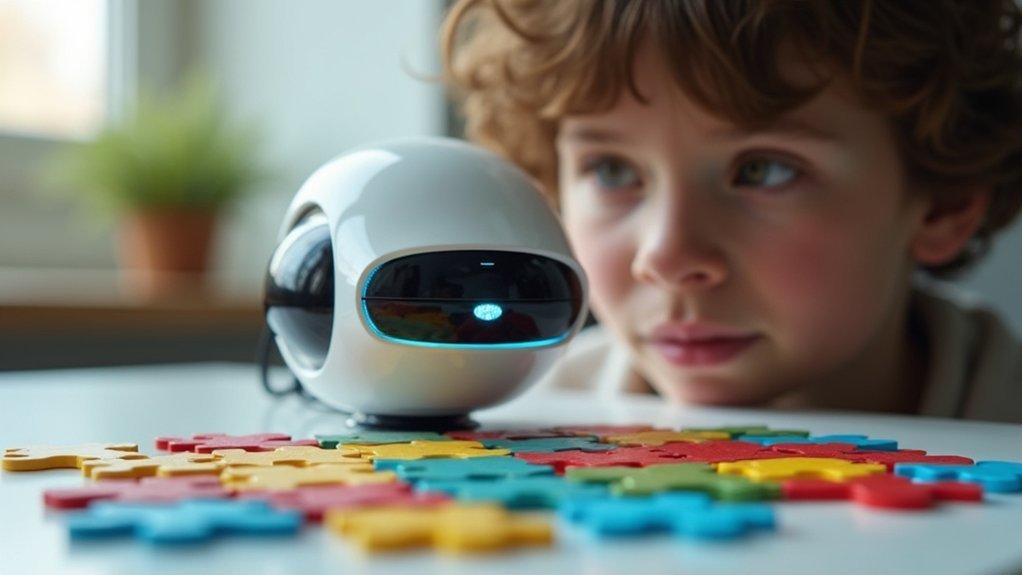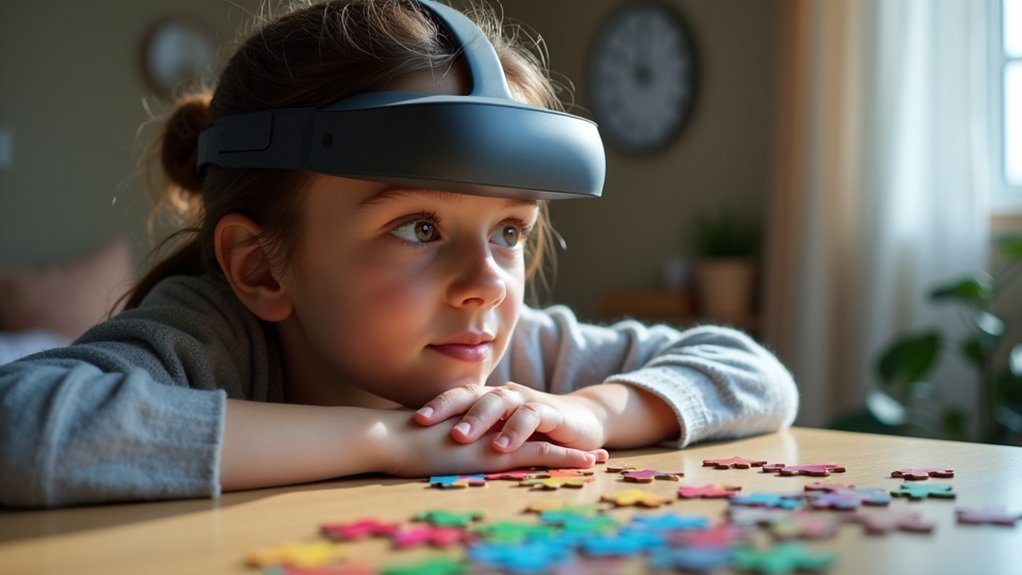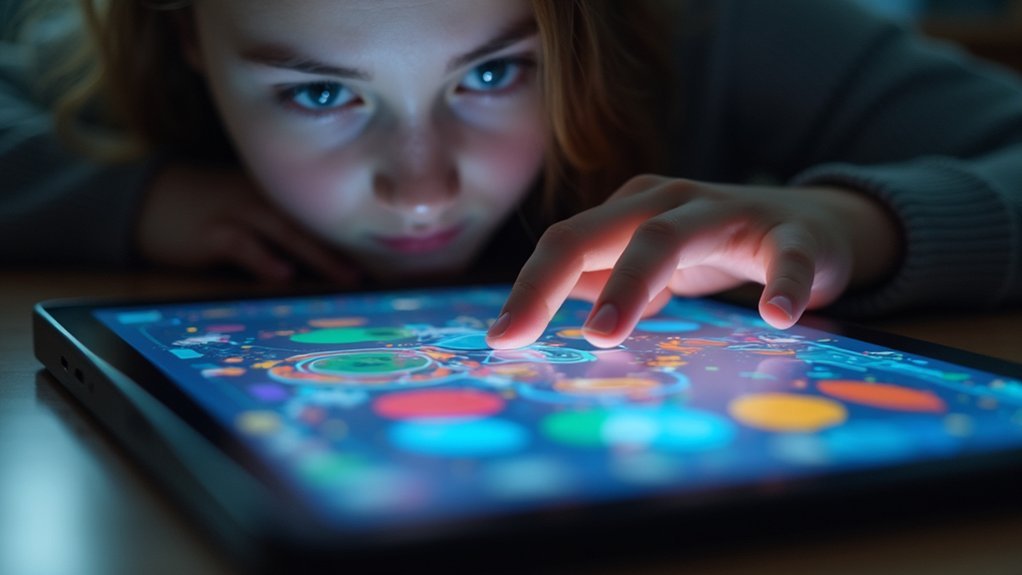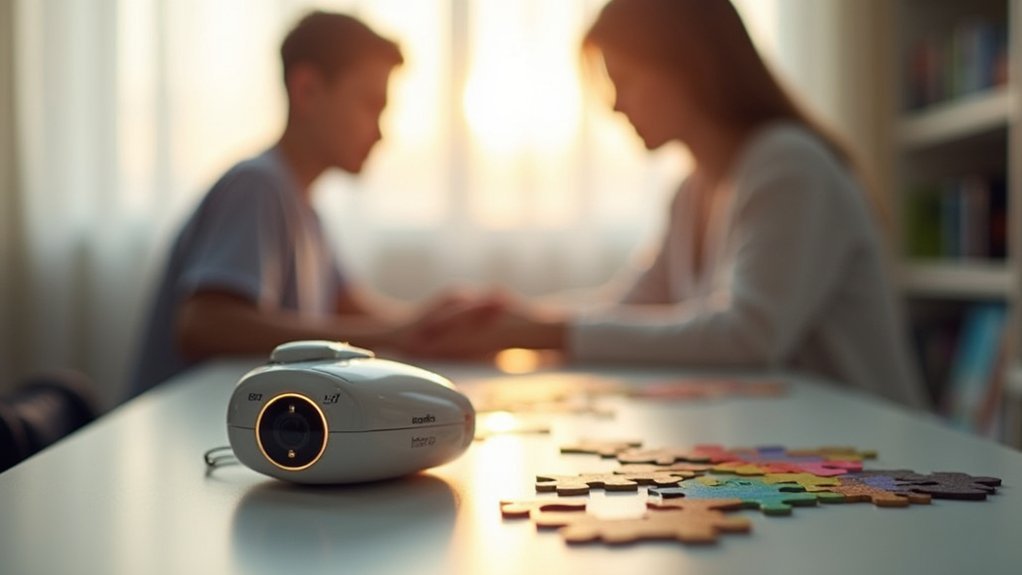Eye-tracking puzzles can boost your cognitive abilities while working around physical limitations. Start with simpler puzzles and gradually increase difficulty to build skills without frustration. Guarantee proper system calibration and positioning for best results. Take regular visual breaks using the 20-20-20 rule. If you wear glasses, choose anti-reflective coatings and thinner lenses. Monitor your progress through saccadic accuracy and fixation metrics. The following tips will transform your rehabilitation journey with technology designed specifically for your needs.
7 Eye-Tracking Puzzle Tips for Paralysis Patients
For those living with paralysis, eye-tracking puzzle games offer a powerful way to maintain cognitive health while providing meaningful interaction.
These games engage multiple brain functions, from attention to executive skills, while providing quantifiable data about your visual strategies.
Start with simpler puzzles that gradually increase in difficulty as you become more comfortable with eye control.
Look for games that provide real-time feedback on your gaze patterns to help develop more efficient visual search techniques.
When solving puzzles, try practicing both wide scanning movements and focused attention on specific details.
Regular sessions of 15-20 minutes can improve your visual search performance and help maintain visuospatial awareness.
Remember that these puzzles aren’t just entertainment—they’re valuable cognitive training tools specifically designed to support your unique interaction needs.
These activities can promote neuroplasticity in the brain, helping to rewire neural connections and potentially improve vision recovery over time.
Selecting the Right Eye-Tracking System for Your Abilities
When choosing an eye-tracking system, you’ll need to find the right balance between calibration requirements and comfort for extended use.
Proper camera positioning greatly impacts tracking accuracy, so look for adjustable mounts that accommodate your specific seating arrangement or bed position.
If you wear glasses or contacts, verify the system you select is compatible with your eyewear, as some trackers struggle with reflections or certain lens types.
Eye-tracking systems vary significantly in their data quality assessments, with some devices like EyeBOX showing more reliable data quality metrics compared to alternatives.
Calibration vs. Comfort Balance
Choosing the right eye-tracking system requires careful consideration of both calibration precision and user comfort. When living with paralysis, you’ll need to balance these factors to guarantee effective communication without causing strain. Recent developments in eye-tracking technology have significantly improved the ability of neurodegenerative patients to communicate effectively with their caregivers and loved ones.
| Calibration Considerations | Comfort Factors |
|---|---|
| Accuracy requirements for your specific needs | Device wearability for extended use |
| Calibration difficulty based on eye movement control | Potential for eye strain during sessions |
| Integration with AAC devices | Customization options for your situation |
| Data quality for precise communication | Regular breaks to prevent fatigue |
| Technical support availability | User training to enhance experience |
For ALS and other paralysis conditions, remember that high-resolution tracking with noise reduction is essential, but not at the expense of comfort. You’ll likely prefer eye-tracking over BCIs due to its intuitive interface and higher information transfer rate.
Camera Positioning Matters
The ideal position of your eye-tracking camera greatly impacts tracking accuracy and overall effectiveness. When setting up your system, place infrared cameras at a suitable distance and angle that provides clear views of your eyes without obstruction.
Be aware that direct sunlight can interfere with infrared technology.
Ensure your chosen system is compatible with your screen size and resolution. The best setups adapt to different lighting conditions, maintaining performance whether you’re in bright or dim environments.
Look for systems that support multiple eye gestures and offer customizable commands to match your specific needs.
Consider whether the system can integrate with your existing mobility devices for seamless control.
Remember that different medical conditions may require specialized positioning—some manufacturers offer clinical support to address eye conditions that might affect tracking performance.
The TD I-Series devices are specifically designed to operate through eye movement alone, providing communication options for those with limited physical abilities.
Eyewear Compatibility Considerations
For many paralysis patients who wear glasses or contact lenses, selecting an eye-tracking system compatible with their eyewear becomes a critical consideration. The infrared technology that powers eye-tracking can be affected by reflections or distortions from eyewear, potentially reducing accuracy.
When choosing your system, focus on these key factors:
- Anti-reflective coating – Glasses with this coating perform better with eye-trackers by minimizing infrared light interference.
- Frame and lens dimensions – Smaller, thinner lenses create fewer tracking obstacles than thick, large frames.
- Calibration options – Look for systems that offer specialized calibration modes for glasses wearers.
Contact lenses typically provide better performance than glasses, as they don’t create the same reflection issues that frames and lenses do. Tobii’s I-Series devices are designed with advanced eye measurement processing for quicker conversation capability even when users have vision correction needs.
Optimizing Calibration for Maximum Comfort and Precision
Because eye-tracking calibration presents unique challenges for paralysis patients, finding the right balance between comfort and precision becomes vital for successful implementation.
Break calibration into multiple short sessions rather than one long procedure to accommodate fatigue and attention variability.
Fragmented calibration sessions prevent fatigue, accommodate attention shifts, and ultimately yield more reliable eye-tracking data.
If you’re working with a patient who’s alternating strabismus, consider single-eye tracking as an alternative to standard two-eye calibration.
For better results, verify calibration targets are visually distinct and properly sized for easier fixation.
Tailor your approach by minimizing fixation time per calibration point and creating a calm, supportive environment to reduce anxiety.
Consider implementing machine learning techniques like ANNs or SVMs to improve accuracy.
Control lighting conditions carefully, as fluctuations can greatly degrade tracking quality.
For patients experiencing locked in syndrome following a stroke, eye tracking may be their primary means of communicating with caregivers and loved ones.
Building Cognitive Endurance Through Progressive Difficulty

You’ll build stronger cognitive endurance by starting with simple eye-tracking tasks that don’t frustrate or fatigue you.
As your abilities improve, gradually increase the complexity and duration of exercises to challenge your brain without overwhelming it.
Implementing timed interval training—alternating between focused engagement and brief rest periods—can effectively expand your attention span while preventing mental exhaustion.
This approach aligns with innovative rehabilitation strategies that combine virtual reality gaming with eye-tracking technology to simultaneously assess cognitive and motor functions in stroke patients.
Subheading Discussion Points
Cognitive resilience develops gradually when patients engage with eye-tracking puzzles that systematically increase in complexity. This progressive approach leverages neuroplasticity, allowing your brain to reorganize and improve functions over time. The technology adapts to your unique abilities, ensuring challenges remain appropriate as your cognitive endurance grows.
For maximum benefit, consider these implementation strategies:
- Schedule regular assessments using standardized tests to monitor your progress and adjust puzzle difficulty accordingly.
- Combine eye-tracking exercises with other cognitive therapies to enhance overall recovery outcomes.
- Utilize immediate feedback mechanisms to reinforce learning and maintain motivation through a sense of achievement.
- Implement graded activities that follow errorless learning principles to strengthen cognitive functions while minimizing frustration during rehabilitation.
This multidisciplinary approach helps develop compensatory strategies that transfer to real-life scenarios, improving your cognitive adaptability while supporting brain injury recovery.
Start Simple, Scale Gradually
When starting with eye-tracking puzzles, the initial difficulty level must match your current abilities to prevent frustration and cognitive overload. Your healthcare provider will assess your baseline cognitive function using tools like MMSE-K to customize your training plan. Research indicates that these eye-movement patterns can provide valuable insights on consciousness levels for patients with severe brain injuries.
| Level | Duration | Features |
|---|---|---|
| Basic | 10-15 min | Simple object tracking, minimal distractions |
| Intermediate | 15-20 min | Multiple objects, moderate time constraints |
| Advanced | 20-30 min | Complex patterns, decision-making elements |
Begin with short, regular sessions focusing on simple tracking tasks. As you build cognitive endurance, you’ll gradually progress to more challenging puzzles that require increased attention and processing speed. Remember to take breaks when needed—this isn’t a race but a journey toward cognitive improvement. Your progress will be monitored consistently, with difficulty adjustments made based on your performance data.
Timed Interval Training
Timed interval training represents a cornerstone approach in building cognitive resilience for paralysis patients using eye-tracking technology.
By introducing time constraints to puzzle-solving activities, you’ll develop better focus and faster neural response times while adapting to pressure situations.
To maximize your cognitive endurance development:
- Start with comfortable time limits and gradually reduce them as your skills improve, encouraging neuroplasticity and strengthening neural connections.
- Incorporate different interval types – alternate between short, intense puzzle-solving periods and longer, more strategic challenges.
- Use the immediate feedback from eye-tracking technology to monitor your progress and adjust difficulty levels accordingly.
This progressive approach not only enhances your cognitive functions but also boosts motivation as you achieve new milestones in your recovery journey. Research suggests that implementing high-intensity intervals similar to HIIT exercise protocols can significantly improve cognitive flexibility and working memory in patients with cognitive impairments.
Preventing Eye Fatigue During Extended Puzzle Sessions

For paralysis patients who rely on eye-tracking technology, extended puzzle sessions can place significant strain on the eyes if proper precautions aren’t taken.
Follow the 20-20-20 rule: every 20 minutes, look at something 20 feet away for 20 seconds while practicing deliberate blinking.
Regular eye breaks are essential. Remember the 20-20-20 rule to refresh your vision during extended puzzle sessions.
Customize your environment by reducing screen glare, adjusting brightness settings, and maintaining proper ambient lighting.
Position your screen at a comfortable viewing distance and guarantee adequate hydration throughout your sessions. Consider incorporating some simple focus flexibility drills to help your eyes shift between your puzzle and distant objects.
Modern eye-tracking systems can monitor your fatigue levels in real-time.
Take advantage of this biofeedback to recognize when you need breaks.
Maintain a leisurely pace during puzzles rather than rushing, and alternate between different types of puzzles to reduce monotony and eye strain.
Measuring Your Progress Through Performance Metrics
Tracking five key performance metrics can greatly enhance how paralysis patients measure their cognitive progress when using eye-tracking technology.
By monitoring these indicators over time, you’ll gain valuable insights into your cognitive function and puzzle-solving abilities. Analyzing your gaze path patterns can reveal improvements in your problem-solving approach and strategic thinking.
Your eye movements tell a powerful story about your brain’s performance. Watch for these key indicators:
- Saccadic accuracy and speed – Improvements here reflect enhanced executive function and processing speed.
- Fixation duration and frequency – Decreased fixation time on puzzles indicates more efficient information processing.
- Error rate reduction – Fewer incorrect selections demonstrates cognitive improvement and better decision-making.
As your metrics improve, you’ll notice puzzles becoming easier.
This data helps your care team adjust difficulty levels appropriately, ensuring you’re always appropriately challenged while documenting your progress.
Customizing Visual Elements for Enhanced Engagement

While tracking your performance metrics provides valuable data, the visual experience itself plays a powerful role in your engagement with eye-tracking technology. You’ll benefit from high-contrast colors and distinct shapes that make puzzle elements immediately recognizable and easier to interact with.
Look for games with clean interfaces that minimize visual clutter, allowing you to focus on the puzzle rather than struggling with navigation. The best experiences offer difficulty levels that adapt to your abilities, preventing frustration while maintaining challenge. Eye tracking technology is especially valuable as it leverages eye movement functionality that typically remains unaffected by illness or paralysis.
Effective feedback mechanisms—visual highlights, sounds, or haptic responses—will confirm your interactions and guide your progress.
When selecting puzzle games, prioritize those with customizable visual settings that accommodate your specific needs and preferences, ensuring an engaging and accessible experience.
Frequently Asked Questions
Can Eye-Tracking Puzzles Help With Depression Associated With Paralysis?
Yes, eye-tracking puzzles can help your depression when you’re paralyzed. They’ll stimulate your brain, provide cognitive challenges, and offer an accessible way to engage in activities that distract from negative thoughts.
How Do Caregivers Learn to Assist With Eye-Tracking Technology?
You’ll learn through foundational training, hands-on practice, and collaborative workshops. You’ll master calibration techniques, troubleshooting skills, and patient-centered communication strategies. You’ll also join support networks to share experiences with other caregivers.
Are Insurance Companies Covering Eye-Tracking Puzzle Systems?
Yes, your eye-tracking puzzle system may be covered by insurance. Medicare, Medicaid, and many private insurers cover these devices when properly prescribed as speech-generating devices under appropriate HCPC codes like e2510.
Can Eye-Tracking Data Predict Cognitive Decline in Neurodegenerative Conditions?
Yes, eye-tracking data can predict your cognitive decline in neurodegenerative conditions by measuring your saccadic movements, fixation patterns, and visual processing speeds – all of which change before obvious symptoms appear in Alzheimer’s and Parkinson’s disease.
How Do Different Cultural Backgrounds Affect Puzzle-Solving Eye Movement Patterns?
Your cultural background shapes how you scan puzzles – East Asians typically exhibit holistic viewing patterns focusing on relationships and context, while Westerners show more analytic eye movements targeting individual objects and focal points.
In Summary
You’ve now got seven powerful strategies to transform your puzzle experience with eye-tracking technology. Whether you’re a beginner or experienced user, these techniques will help you play longer, with greater precision, and more enjoyment. Remember, your journey is unique—adapt these tips to your specific needs, celebrate small victories, and don’t hesitate to modify your approach as your abilities evolve.





Leave a Reply